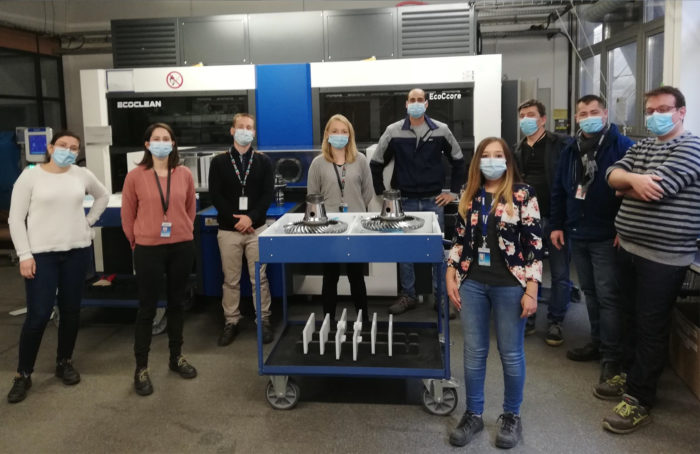Meet Alyssa Momprivé, Chemical and Cleanliness Analysis Technician at Testia Marignane (at the forefront on the picture)

I work within Airbus Helicopters‘ Cleanliness Department. Here, Testia supports Airbus in rinsing and analysing new engine parts in order to reduce their pollution (the COOPSOC handles the cleaning of the parts). This activity is still at a testing stage and we work together with Airbus to define the right criteria. This activity began in April 2019 and so far we have washed over 3000 parts in our lab!
What is the process?
First of all, the parts we analyse shall be cleaned in a big washing machine. Once cleaning is done, my role consists in taking the parts and checking whether they are compliant with Airbus’s criteria, meaning they don’t have too many metallic particles (if they do, they shall go back to the washing machine).
Once the visual inspection is completed, I place the parts on the extraction bench (which works like a big funnel). There, I apply a solvant on them, according to a protocol which is established according to the parts‘ type, and then extract a membrane. I then take this membrane to a polarised light microscope to read it and count the number of mettalic particles it is comprised of. Eventually, I check if those particles are well-scaled in order to sanction their compliance, or not. According to Airbus’s criteria, a set number of particles musn’t be exceeded according to their size. For instance, we cannot accept particles over 400 micrometers.
Compliant parts can then be taken to storage and wait to be assembled on an engine.
Do you do that for every single part?
No! All parts are thoroughly washed, however my job so far consists in sampling, usually 2 to 6 parts from a batch according to their sizes. In the end, the control shall be systematic and part of the whole quality process, but so far we’re still at a testing stage.
Moreover, our lab is not equipped yet to take up all parts at the moment: the washing machine cannot host larger pieces and the extraction bench cannot hold more than 25 kilos. Yet by the end of the year, we will get new equipment with a much bigger washing machine and a new extraction bench that shall be able to host much bigger parts such as carters and rotor masts.
What is the goal of this approach?
Following a certain amount of helicopter accidents, Airbus analysed the parts‘ chain and realised there were metallic particles. Those particles, in a small quantity, do not pose a threat. However, the bigger and the more numerous they are, the more risks there are of damaging the engine (with the particles going to fuel and oils for example).
Hence our mission is a preventive one, so as to produce cleaner engines and thus avoiding accidents and making helicopters safer.
Is this approach only applicable to new engine parts or could it be adapted to other siuations?
Right now, we are working with automotive standards – no doubt this methdod could be applied in other industries!
As for helicopters, we currently only work with new parts, yet it is very much possible to think that, in the future, we shall also use this method on MRO/maintenance parts in order to confirm whether or not they can be reassembled safely back on the helicopter.
In addition to this experimental activity, Testia’s Chemical Testing Department offers a wide portfolio of services dedicated to the Aerospace Industry. Find out more information about our lab here.
